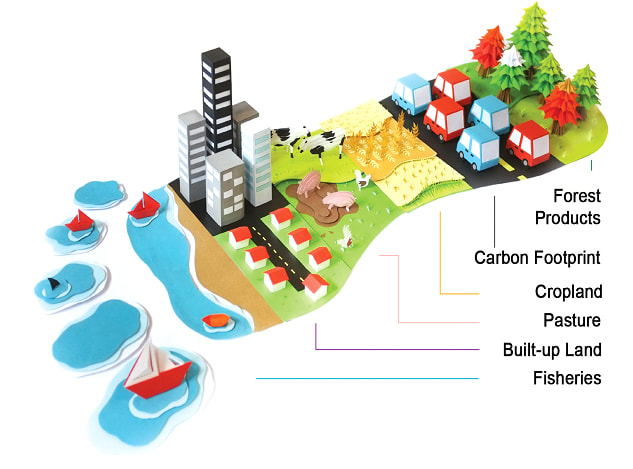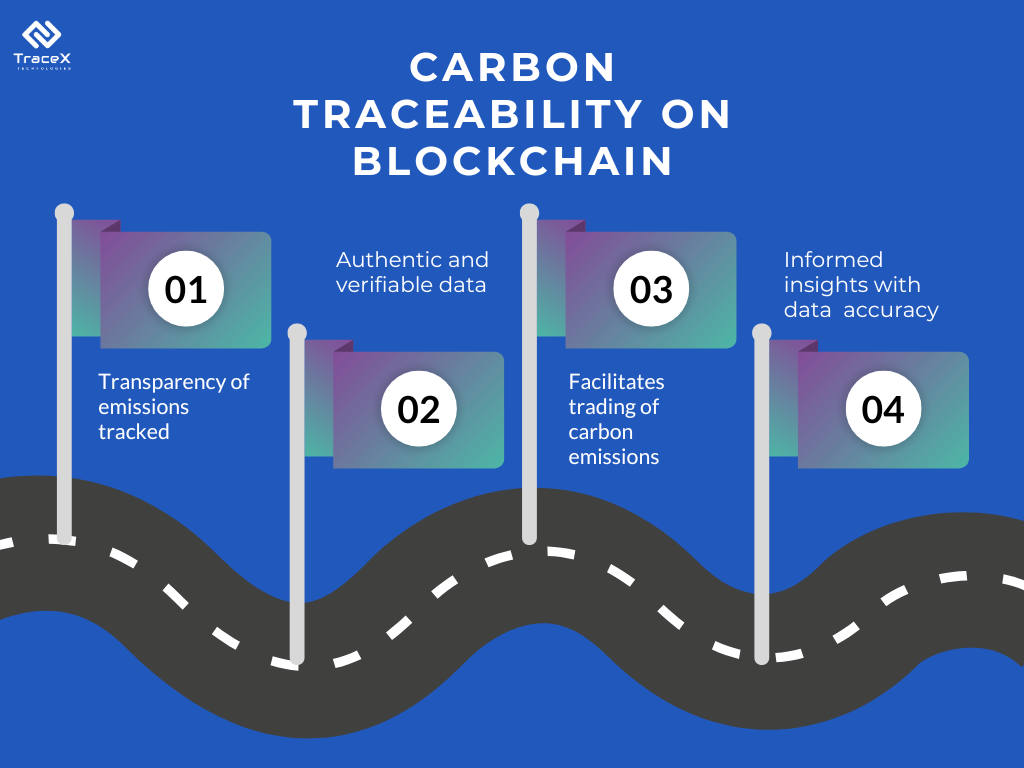Contact: +91 99725 24322 |
Menu
Menu
Quick summary: Confused by carbon footprints? Blockchain sheds light! This blog explores how blockchain technology empowers businesses and consumers to track emissions and fight climate change through transparent carbon traceability. Discover real-world applications and the path to a sustainable future.

Climate change is no longer a looming threat, it’s a reality we face every day. From extreme weather events to rising sea levels, the impact of our carbon footprint is undeniable. Businesses and consumers alike are increasingly aware of the need to reduce emissions, but accurately measuring and tracking carbon remains a significant challenge. Carbon Traceability with blockchain is a game-changer. Imagine a system that tracks carbon emissions throughout a product’s lifecycle, from raw materials to final consumption. A system that is transparent, secure, and verifiable.
Our planet is facing a critical challenge: climate change. This complex issue is fueled by greenhouse gas emissions, primarily carbon dioxide, released through human activities. The term carbon footprint refers to the total amount of greenhouse gases, particularly carbon dioxide (CO2), generated by an individual, organization, event, or product throughout its lifecycle. These emissions trap heat in the atmosphere, causing a gradual rise in global temperatures, disrupting weather patterns, and leading to rising sea levels.
Do you know what an Ecological Footprint is? It measures the extent to which mankind is using nature’s resources faster than they can regenerate. It is a tool to address the underlying issue of sustainable consumption. The ecological footprint measures how much bio-productive area, land, or water, humanity would require to produce on a sustainable basis the renewable resources it consumes and to absorb the waste it generates. Biocapacity measures the bio-productive supply available within a certain area of land.
These two concepts of Ecological footprint and Biocapacity were coined by the 1Global Footprint Network (GFN) and are quantified as Global Hectares (gha). If the ecological footprint of the human population is greater than the biocapacity then the environment is supposed to be unsustainable.
And do you know that the worldwide human ecological footprint is 2.8 global hectares/per capita while the total worldwide biocapacity is 1.7gha/capita?
That means humanity is using 1.65 times as many resources sustainably available. Whereas low-income countries have a typical footprint of 1.0 gha/capita, high-income countries have a footprint of 6.2 gha/capita. When carbon footprint is reported with context to the Ecological footprint, the tonnes of carbon dioxide emissions are expressed as the amount of productive land area required to sequester those carbon dioxide emissions.
The process of capturing and storing carbon dioxide in the atmosphere is known as Carbon Sequestration. Stabilizing carbon in solid and dissolved form prevents global warming. Carbon dioxide is produced both in nature and through human activities. The burning of fossil fuels and natural gases for transport and power generation leads to the release of carbon dioxide. The natural factors that emit carbon dioxide are the decomposition of organic matter and forest fires. Carbon dioxide traps heat and causes climatic changes. Carbon sequestration is not the only solution to this Carbon problem. It is just that the planet does not have the biocapacity to neutralize the carbon buildup.
The scientific consensus is clear: reducing carbon emissions is crucial to mitigate the worst effects of climate change. This has driven a growing focus on carbon emission tracking. Traditionally, tracking carbon emissions has been a complex and often opaque process. against climate change. Blockchain is a revolutionary technology that creates a secure, transparent, and decentralized digital ledger. Imagine a shared record-keeping system where everyone can see the information, but no one can tamper with it. This unique characteristic makes blockchain ideal for tracking carbon emissions throughout a product’s journey, from raw material extraction to final consumption. In the following sections, we’ll explore the limitations of traditional carbon tracking methods and how blockchain technology can usher in a new era of transparency, accountability, and sustainable practices in our fight
While the need for carbon emission tracking is clear, traditional methods often struggle to keep pace with the complexity of our globalized world.
The key to carbon tracking is transparency and this needs to be accurate and complete. The data regarding the carbon emissions at each stage needs to be gathered or at least estimated. This requires greater integration and coordination between multiple nodes in the ecosystem. Organizations need to have better visibility and insights to make decisions on the data collected.
Blockchain provides the right platform to collect and track trusted data accurately and reduce the carbon footprint in the food supply chain. Capturing carbon measurement across all supply chain participants into an immutable ledger facilitates audit trails, assuring traceability, security, and accountability. This platform helps to trace the life cycle of a particular product, verify its origin and measure how the carbon footprints increment at each stage in the supply chain.

The carbon emissions can be tracked from the producer to the end consumer in the agriculture value chain. The stakeholders that purchase the crops have very little visibility on the carbon footprint generated and even though it is captured, they are lost in the next transition point due to lack of interoperability. This can be addressed by a few practices that can be incorporated among the various stakeholders in the chain. Agriculture and Deforestation are the important causes of greenhouse gas emissions. They make up a large share of the carbon footprint. The farmer needs to implement smart agriculture practices by evaluating the impact on the environment. The processors and the logistics providers need to consider sustainable initiatives in their processes and the end consumers have to make informed purchases. Adoption of climate-smart practices, creating new revenue streams to those who use this technology, and following agronomic practices to reduce the carbon footprint will help out to reach the Sustainable Development goals.
Organizations need to be instrumental in bringing about a reduction in greenhouse gas emissions and lead the way to a net-zero, weeding out the roadblocks that come their way with the help of Carbon traceability.
Imagine a world where consumers can scan a QR code on their morning coffee and see the carbon footprint associated with those beans, from the farm where they were grown to the roasting and packaging process. Blockchain-based platforms are making this a reality. Technology platforms like TraceX are empowering farmers to track and record their agricultural practices, including fertilizer use and energy consumption. This data is then uploaded onto a blockchain ledger, allowing consumers to see the sustainability efforts behind their food choices.
The concept of carbon offsetting involves investing in projects that reduce emissions elsewhere to compensate for your own footprint. However, traditional offset programs have faced challenges with transparency and verifying the actual impact of these projects. Blockchain is changing this narrative. Platforms like Verra are utilizing blockchain to track and verify carbon offset projects, ensuring the emission reductions they represent are real and measurable. This increased transparency fosters trust in the carbon offset market, making it a more viable tool for businesses and individuals to achieve carbon neutrality. The TraceX DMRV platform brings credibility to carbon offset projects thereby ensuring quality carbon credits in the voluntary carbon markets.
The Kyoto protocol of 1997 paved the way for the carbon credit system. The carbon credit systems awards credits to organizations that exceed the nationally determined emission quota standards by reducing their carbon emission. 1 carbon credit is awarded to the organization that has reduced carbon emission equivalent to 10 tons of carbon dioxide or its equivalent gases. The carbon trade allows parties that emit a higher amount of carbon higher than the permitted limit to purchase or exchange credits from parties that have lowered their carbon emissions less than the permitted limits thereby balancing the carbon emissions emitted into the atmosphere.
Carbon trading brings value to the consumers and makes the planet a better place to live. Providing information on the carbon footprint of each product through carbon emission labels will bring transparency and the eco-friendly value of the product. Consumers will be encouraged to make informed decisions about their eco-friendly purchases. Carbon trading and Carbon emission systems can harness the power of Blockchain technology and re-engineer the food supply chains.
The fight against climate change demands a multi-pronged approach, and blockchain-enabled carbon traceability offers a powerful weapon in our arsenal. By promoting transparency, accountability, and improved data tracking throughout supply chains, blockchain empowers businesses and consumers to make informed decisions that prioritize sustainability. As this technology continues to evolve and gain traction, we can expect a future where carbon footprints are not shrouded in mystery, but rather transparent and actionable, paving the way for a more sustainable and climate-conscious world.
